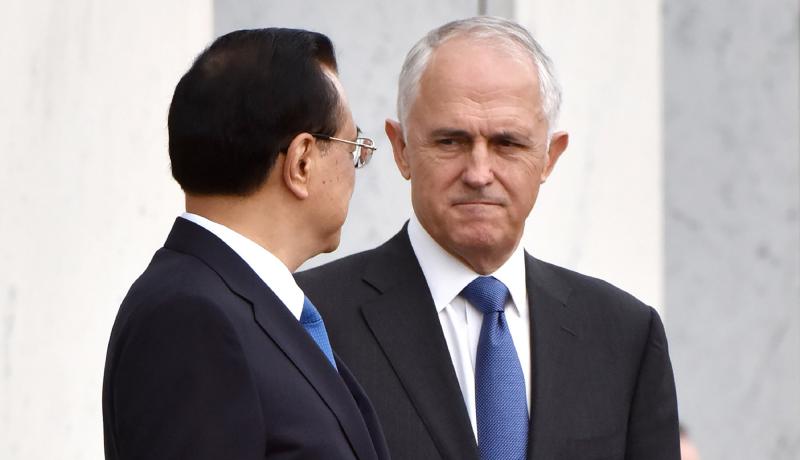
Australia’s recently released foreign policy white paper, the first to be produced in 14 years, tries to bring together two competing tensions. First, Australia’s region is in the process of being redefined by greater Chinese influence and decreased US dominance. That requires Canberra to assert its own agency in a contested space. Second, and more complicated, is the reality of Australia’s relations to these two major powers. Australia’s security is tied to an alliance with Washington, but economically China is by some distance its major trading partner.
The white paper states that ‘more than ever, Australia must be sovereign, not reliant’, but it understands that whatever stability can be achieved – whatever space for Australian agency – will be dependent on the relationship between the US and China. The anxiety stemming from this reactive dynamic is reflective of trends present throughout the region’s states, but it is especially pronounced for Australia.
If Australia is to act with greater independence, it has to first determine its identity. This is a historical debate which is now sharper than ever. Is Australia a Western outpost in the region, defined by its alliance with Washington, membership of the Five Eyes intelligence network and latent Anglosphere connections, or is it an Asian nation in its own right? Greater connections to China look different depending on where Australia sits on that spectrum.
Equally, how does Australia understand its region? The phrase used throughout the white paper is ‘Indo-Pacific’, an in vogue term broad enough to allow both the US and India to be included in a region increasingly defined by Chinese power and influence. From Beijing, the nomenclature alone will look like a wary hedge.
Between the powers
The white paper doubles-down on Australia’s relationship with the United States as its most important partner. The commitment is clear, but is repeated with such frequency that it sounds like an alarm bell.
At the recent Asia-Pacific Economic Cooperation meeting, the signals were that President Trump would make a speech which meshed with the white paper, advocating a ‘free and open Indo-Pacific’. Instead, Trump used the speech to castigate the region’s leaders for their approaches to trade. America First transactionalism, on a bilateral basis, does not look much like the ‘long-term vision’ of a ‘region-wide free trade area that includes all major economies’ which the white paper advocates. US influence was on the wane before Donald Trump assumed the presidency, but his approach has brought the question mark over America’s commitment into stark relief.
In contrast, China, according to Xi Jinping’s speech in October, is committed to ‘moving closer to centre stage’ and is doing so on its own terms. Much of China’s vision is linked to its Belt and Road Initiative, but the Asian Infrastructure Investment Bank aside, there is no wider governance mechanism to what remains a bilateral enterprise. The white paper anxiously highlights this by stating that where trade and investment have previously been regarded as ameliorating conflict, they may now be exacerbating it.
What can Australia do between the powers, to try to ‘protect a shared vision for the region and to support a balance in the region favourable to our interests’?
One response the paper proposes is increased engagement by Australia with the ‘region’s major democracies’, defined as India, Indonesia, Japan and South Korea. This is endorsed in both bilateral terms and in smaller groupings. It makes sense, but will again be viewed with scepticism in Beijing which regards initiatives such as the renovation of the ‘Quad’ as containment.
But as a statement of Australia’s identity it is something nonetheless. Credibility will depend on Australia demonstrating consistent autonomy to avoid being seen as the weak link in the chain. New foreign influence legislation, announced this week, is partly prompted by rising concern at Chinese influence through higher education and political donations. That may go some way to bolster Canberra’s case.
It could be given greater purchase if backed by wider engagement on issues such as climate change and migration where Australia could accrue greater credibility as a responsible stakeholder. This is especially the case in its immediate neighbourhood; many of the Pacific island countries will face existential challenges from environmental factors. This will drive migration, and Australia’s international reputation is currently tied to a negative narrative of offshore processing and tow-back hostility to those who arrive on its shores. The white paper addresses the neighbourhood in chapter six, but it is under-developed on specifics beyond existing trade initiatives, and climate issues are not covered in depth.
Ultimately, this new foreign policy vision succeeds as a clear-eyed assessment of Australia’s geopolitical situation, but it does not provide answers to its most pressing questions. It largely hopes to balance China’s influence by firmer commitment to the US alliance, but the good grace of US engagement cannot be taken for granted, nor the Trump effect be dismissed as a blip. And ultimately the country must wonder: has the space to contain US–China rivalry within a rules-based regional architecture already disappeared?
James Hannah, Assistant Head, Asia Programme.
